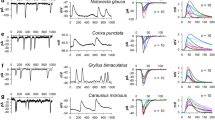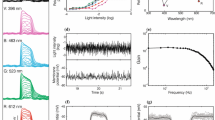Summary
-
1.
Intracellular recordings from the photoreceptors of the locustsLocusta migratoria andValanga irregularis and the flyCalliphora stygia, were used to examine the differences between theV/logI curve (intensity/response function) determined in the dark adapted and the light adapted state.
-
2.
For response amplitudes less than half the maximum the fully light adaptedV/logI curve follows the simple self-shunting model, where the number of channels activated is proportional to the number of photons absorbed.
-
3.
We fitted ourV/logI curves with the commonly employed hyperbolic function Eq. (1), and found a consistent deviation of the experimental data from the predicted curves when responses exceeded half maximal amplitude.
-
4.
The light adaptedV/logI curves of locusts exhibit a ‘kink’ deformation (Fig. 3) and 4 of the 80 cells recorded from locusts had a small spike superimposed on the rising phase of the photo-response (Fig. 1). No kink or spike was observed in the flyCalliphora.
-
5.
Transmembrane recording with a double electrode eliminated the ERG as a candidate for changing the slope and producing the kink or the spike. Stimulation of single ommatidia also ruled out interommatidial interactions.
-
6.
Change in pulse duration did not affect the slope or the shape of theV/logI curves.
Similar content being viewed by others
References
Baumann F (1968) Slow and spike potentials recorded from retinula cells of the honeybee drone in response to light. J Gen Physiol 52:855–875
Baylor DA, Fuortes MGF (1970) Electrical responses of single cones in the retina of the turtle. J Physiol 207:77–92
Dowling JE, Ripps H (1972) Adaptation in skate photoreceptors. J Gen Physiol 60:698–719
Fain GL, Lisman JE (1981) Membrane conductances of photoreceptors. Prog Biophys Mol Biol 37:91–147
French AS (1980) The linear dynamic properties of phototransduction in the fly compound eye. J Physiol 308:385–401
Horridge GA, Tsukahara Y (1978) The distribution of bumps in the tail of the locust photoreceptor afterpotential. J Exp Biol 73:1–14
Kleinschmidt J, Dowling JE (1975) Intracellular recordings from gecko photoreceptors during light and dark adaptation. J Gen Physiol 65:617–648
Koike H, Brown HM, Hagiwara S (1971) Hyperpolarization of a barnacle photoreceptor membrane following illumination. J Gen Physiol 57:723–737
Laughlin SB (1981a) Neural principles in the peripheral visual system of invertebrates. In: Autrum H (ed) Handbook of sensory physiology, vol VII/6B. Springer, Berlin Heidelberg New York, pp 133–280
Laughlin SB (1981b) A simple coding procedure enhances a neuron's information capacity. Z Naturforsch (in press)
Laughlin SB, Hardie RC (1978) Common strategies for light adaptation in the peripheral visual systems of fly and dragonfly. J Comp Physiol 118:319–340
Leonard RJ, Lisman JE (1981) Light modulates voltage-dependent potassium channels inLimulus ventral photoreceptors. Science 212:1273–1275
Lillywhite PG (1977) Single photon signals and transduction in an insect eye. J Comp Physiol 122:189–200
Lipetz LE (1971) The relation of physiological and psychological aspect of sensory intensity. In: Loewenstein WR (ed) Handbook of sensory physiology, vol I. Springer, Berlin Heidelberg New York, pp 191–225
Loewenstein WR (1959) The generation of electrical activity in a nerve ending. Ann NY Acad Sci 81:367–387
Martin FG, Mote MI (1980) An equivalent circuit for the quantitative description of inter-receptor coupling in the retina of the desert antCataglyphis bicolor. J Comp Physiol 139:277–285
Naka KI, Rushton WAH (1966a) S-potentials from colour units in the retina of fish (Cyprinidae). J Physiol 185:536–555
Naka KI, Rushton WAH (1966b) S-potentials from luminosity units in the retina of fish (Cyprinidae). J Physiol 185:587–599
Normann RA, Perlman I (1979) Evaluating sensitivity changing mechanisms in light-adapted photoreceptors. Vision Res 19:391–394
Normann RA, Werblin RS (1974) Light and dark adaptation of vertebrate rods and cones. J Gen Physiol 63:37–61
Payne R (1980) Voltage noise accompanying chemically-induced depolarization of insect photoreceptors. Biophys Struct Mech 6:235–251
Payne R, Howard J (1981) The response of an insect photoreceptor: a simple lognortnal model. Nature 290:415–416
Pepose JS, Lisman JE (1978) Voltage sensitive potassium channels inLimulus ventral photoreceptors. J Gen Physiol 71:101–120
Shaw SR (1967) Simultaneous recording from two cells in the locust retina. Z Vergl Physiol 55:183–194
Shaw SR (1969) Interreceptor coupling in ommatidia of drone honeybee and locust compound eyes. Vision Res 9:999–1029
Shaw SR (1975) Retinal resistance barriers and electrical lateral inhibition. Nature 255:480–483
Shaw SR (1978) The extracellular space and blood-eye barrier in an insect retina: an ultrastructural study. Cell Tissue Res 188:35–61
Tsukahara Y, Horridge GA (1977a) Interaction between two retinula cell types in the anterior eye of the droneflyEristalis. J Comp Physiol 115:287–298
Tsukahara Y, Horridge GA (1977b) Miniature potentials, light adaptation and afterpotentials in locust retinula cells. J Exp Biol 68:137–149
Wilson M, Garrard P, McGinness S (1978) The unit structure of the locust compound eye. Cell Tissue Res 195:205–226
Wong F (1978) Nature of light-conductance changes in ventral photoreceptors ofLimulus. Nature 276:76–79
Wu CF, Pak WL (1978) Light-induced voltage noise in the photoreceptor ofDrosophila melanogaster. J Gen Physiol 71:249–268
Zettler F (1969) Die Abhängigkeit des Übertragungsverhaltens von Frequenz und Adaptationszustand, gemessen am einzelnen Lichtrezeptor vonCalliphora erythrocephala. Z Vergl Physiol 64:432–449
Author information
Authors and Affiliations
Additional information
We thank J. Howard and R. Payne for many useful discussions.
Rights and permissions
About this article
Cite this article
Matić, T., Laughlin, S.B. Changes in the intensity-response function of an insect's photoreceptors due to light adaptation. J. Comp. Physiol. 145, 169–177 (1981). https://doi.org/10.1007/BF00605031
Accepted:
Issue Date:
DOI: https://doi.org/10.1007/BF00605031




